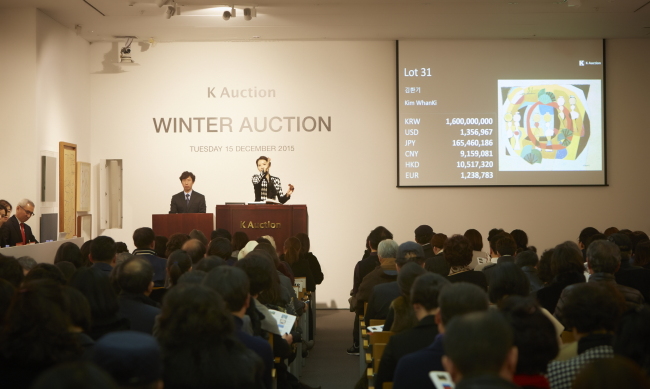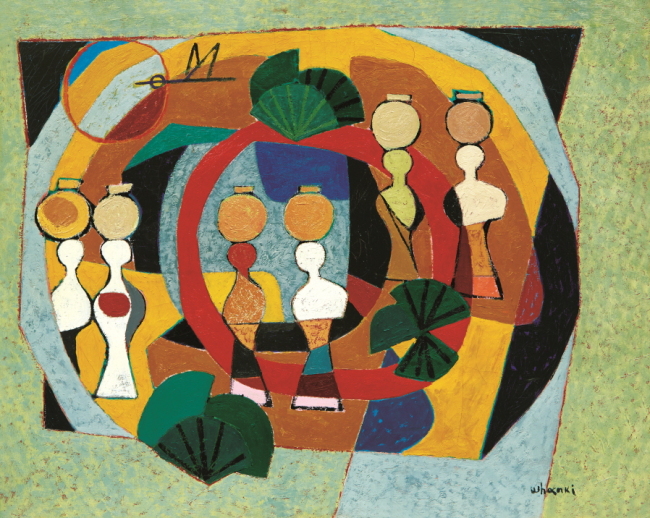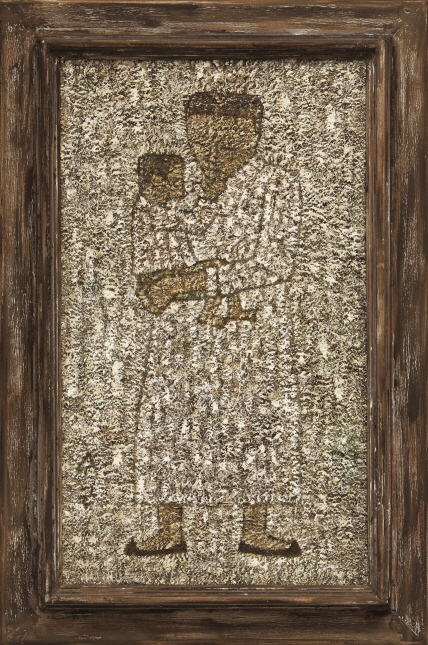Korean art auctions lead strong sales
Seoul Auction, K Auction attract strong bidding for modern and contemporary Korean art
By 박형기Published : Dec. 20, 2015 - 18:39
Korea’s two biggest auction houses -- Seoul Auction and K Auction -- led strong sales at their winter auctions last week, thanks to record sales and strong bidding for “dansaekhwa” monochrome paintings.

The two auction houses achieved hammer prices of 10 billion won ($10 million) with 80 percent of auctioned items sold. With works by Kim Whanki and Lee U-fan leading sales, paintings by dansaekhwa masters such as Park Seo-bo, Ha Chong-hyun and Kwon Young-woo all sold within their price estimates.
“The art market is in its recovery stage, driven by the popularity of dansaekhwa. The dansaekhwa effect also affected overall sales of modern and contemporary art,” said Sohn Yee-chun, auctioneer at K Auction.
A new auction record was set at Seoul Auction’s winter sales on Wednesday last week.
The Buddhist scroll painting “Cheongnyangsan Gwaebultaeng” was sold for 3.62 billion won ($2.98 million), becoming the most expensive Korean work of art sold there.
The Joseon-era painting, made in 1725 and registered as the Korea’s National Treasure, was the biggest item on the block, measuring 442 centimeters in width and 959.9 centimeters in height, almost as high as a three-story building. The scroll used to be hung at outdoor Buddhist services held at Cheongryangsa Temple in Andong, North Gyeongsang Province.
It was reported to be consigned by the owner of a private museum and sold to another private museum in a phone bid.

K Auction’s highlight piece was the 1940s painting “Island Sketches” by Kim Whanki, which fetched a hammer price of 1.6 billion won. The painting drew interest as it was presented with an undisclosed price estimate that was only offered upon request.
The painting was consigned by Ahn Byung-kwang, pharmacy business magnate and art collector. The painting was showcased in an exhibition in 2014 at his Seoul Museum, founded in 2012. Ahn purchased the painting at a Christie’s New York auction in September 2013 at approximately $800,000, according to a source.

Park Soo-keun’s 1964 painting “Mother and Son” drew competitive bids, sold for 830 million won after 23 bids. The painting was shown to the Korean auction for the first time as it had been owned by an American collector since 1964.
Both art auctions, with combined market dominance of more than 80 percent, saw its sales soar compared to previous years, a sign for recovery in the Korean art market. Seoul Auction announced a hammer price of more than 100 billion won, a record for the auction house.
“Foreign sales accounted for some 60 percent of the total sales in 2015,” said Son Ji-sung, head specialist of marketing team of Seoul Auction.
K Auction also performed well this year, realizing 60 billion won in combined hammer price, up from 27 billion won last year. Foreign sales also made up 49 percent of the total hammer price.
Both auction houses held respective auctions in Hong Kong this year, in time for major art fairs and auction scheduled in Asia’s art hub.
“Korean auction houses have become globalized,” said Seo Jin-su, professor of Kangnam University, who has been studying art market records in Korea and Asia. “The successful sales records are underpinned by strong sales of dansaekhwa globally.”
Kim Whanki and Lee U-fan have been front-runners in the Korean art sales, but they are joined by emerging dansaekhwa artists such as Jeong Sang-hwa, Park Seo-bo, Yun Hyong-keun and Ha Chong-hyun recently. The modern and contemporary Korean art masters attributed to growing sales of Korean art globally, Seo explained.
“With the success of the top- and second-tier artists in the global art market, the market holds more potential for third- and fourth-tier artists in the future,” said Seo.
“It shows that the country needs sound global strategies in terms of global promotion of more artists.”
By Lee Woo-young (wylee@heraldcorp.com)



![[Herald Interview] 'Amid aging population, Korea to invite more young professionals from overseas'](http://res.heraldm.com/phpwas/restmb_idxmake.php?idx=644&simg=/content/image/2024/04/24/20240424050844_0.jpg&u=20240424200058)












![[KH Explains] Korean shipbuilding stocks rally: Real growth or bubble?](http://res.heraldm.com/phpwas/restmb_idxmake.php?idx=652&simg=/content/image/2024/04/25/20240425050656_0.jpg&u=)

